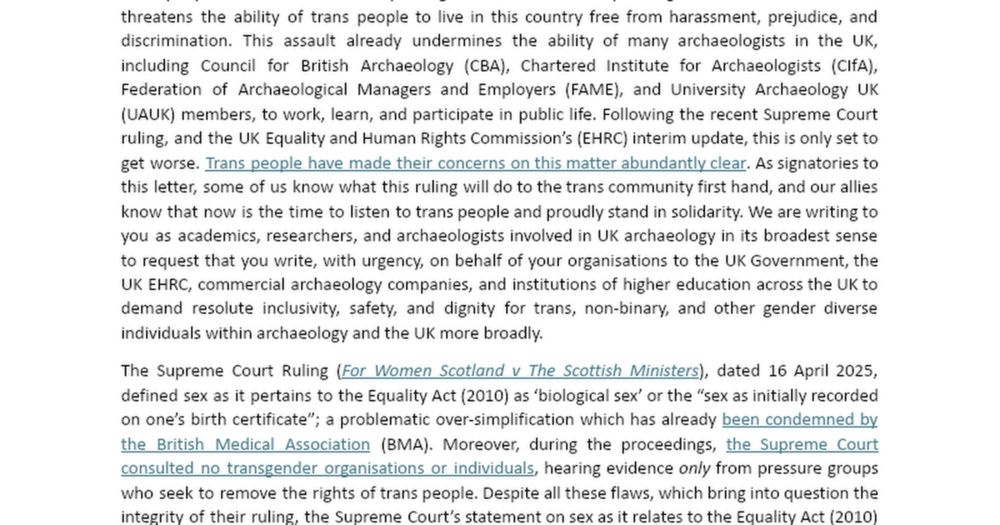
UK ARCHAEOLOGISTS
Please sign this open letter to UK Archaeological associations to urge solidarity with trans archaeologists and action in light of the horrendous EHRC guidance:
docs.google.com/document/d/1...
@ecbrownlee.bsky.social
Research fellow @GirtonCollege @UCamArchaeology Early Medieval Europe | Death & Burial | GIS | Occasional Vikings She/her

UK ARCHAEOLOGISTS
Please sign this open letter to UK Archaeological associations to urge solidarity with trans archaeologists and action in light of the horrendous EHRC guidance:
docs.google.com/document/d/1...
🛏 I spoke with Dr. @ecbrownlee.bsky.social about her work on early medieval bed burials; in this clip, Emma talks about the very touching concern for the dead's comfort in the grave that this burial type seems to suggest.
📺 Watch youtu.be/fA6Wep5aO4Q?...
🎙 Listen open.spotify.com/episode/3BJd...
Published with my excellent colleagues Alison Klevnäs, Astrid Noterman, and Cecilia Ljung (Uppsala University)
20.12.2024 20:02 — 👍 0 🔁 0 💬 0 📌 0
A hand wearing a blue nitryl glove holding a long bone, with green copper staining on the end
Finally, even though these people had been separated from the objects they were buried with, copper staining gives some indication. Combined with the c14 dates, we can see that people were being buried with objects into the 12th and 13th centuries, later than expected
5/5
The population buried around these first churches were in good health, but there's some evidence of the use of teeth as tools, and some deliberately tooth filing. They were mostly female, and as they came from the north side of churches, this suggests sex segregation
4/5
C14 dates from each individual, corrected for marine fish consumption, show that these churchyards started to be used for burial in the first half of the 11th century, which matches historical records of Gotland's conversion.
3/5

An old crumpled newspaper in Swedish. The date is 14th January 1950, and it is stamped with a delivery address in Garda
We analysed antiquarian finds from around churches in Gotland. These were found by gravediggers and had been stored without much documentation, separated from the better recorded objects, but their newspaper wrappings provided some hints as to which sites they came from.
2/5

A black and white photograph of a collection of artefacts. They include three triangular brooches, a bracelet, a ring, a hairpin, and a string of beads.
New publication just in time for Christmas, in Current Swedish Archaeology! Osteological analysis and c14 dating of human remains from the first churchyard burials on Gotland.
1/5
publicera.kb.se/csa/article/...
Those are the only ones I have in my database! Which isn’t definitely comprehensive, but it’s not too far off. I make it 10 in total.
16.12.2024 22:02 — 👍 1 🔁 0 💬 1 📌 0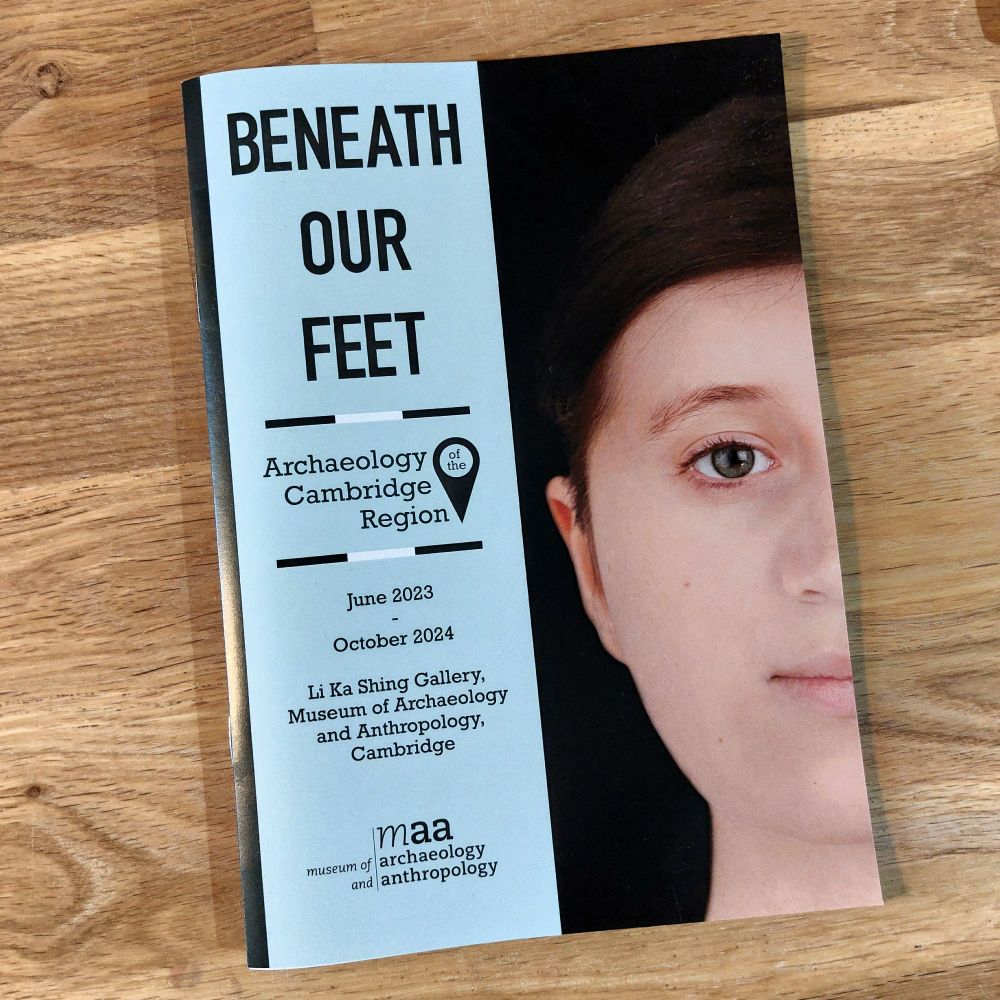
Photograph of the exhibition booklet for the 'Beneath our Feet: Archaeology of the Cambridge Region' exhibition at the MAA in Cambridge. The cover shows a facial reconstruction of a early medieval female found buried at Trumpington.
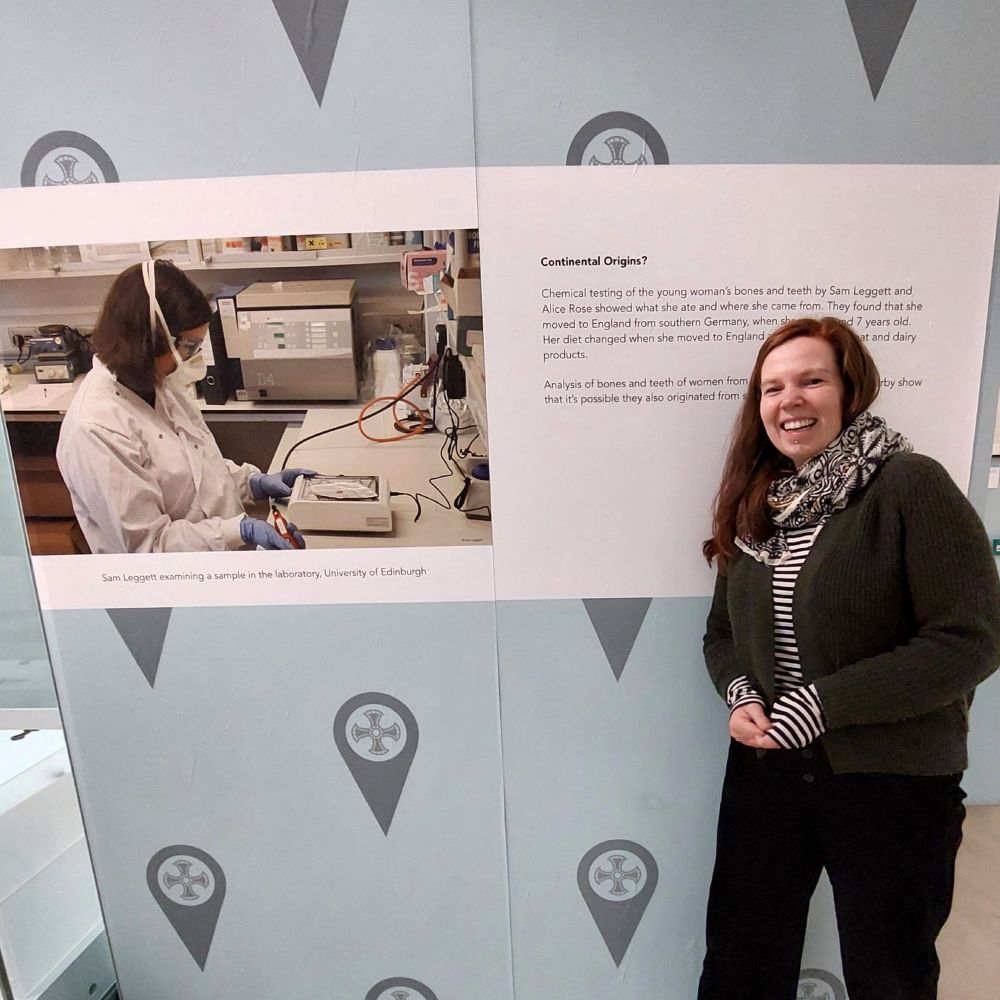
Photograph of the author, Alice Rose, standing in front of an information board in the 'Beneath our Feet' exhibition. The board describes scientific work that Alice Rose and Sam Leggett carried out on the Trumpington burial.
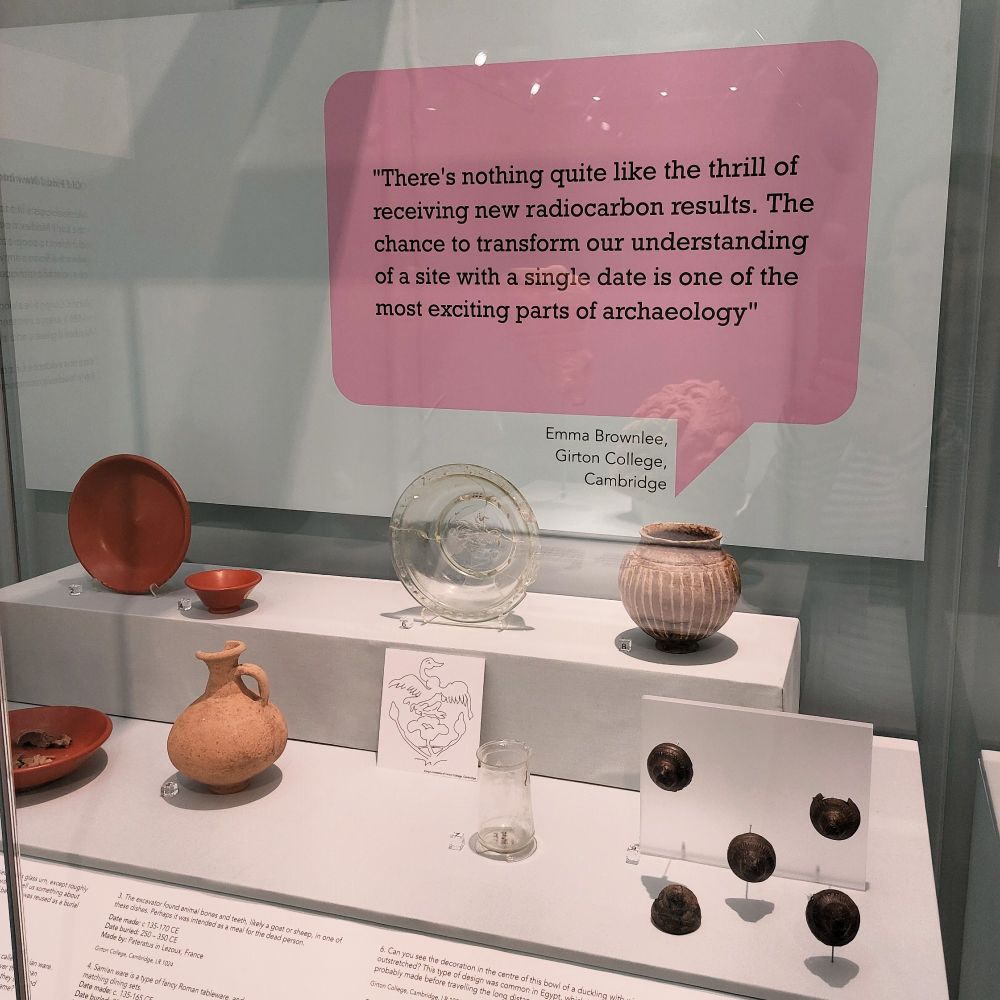
A photograph of a display of Roman and early medieval artefacts found at Girton College. The display includes a quote from Emma Brownlee.
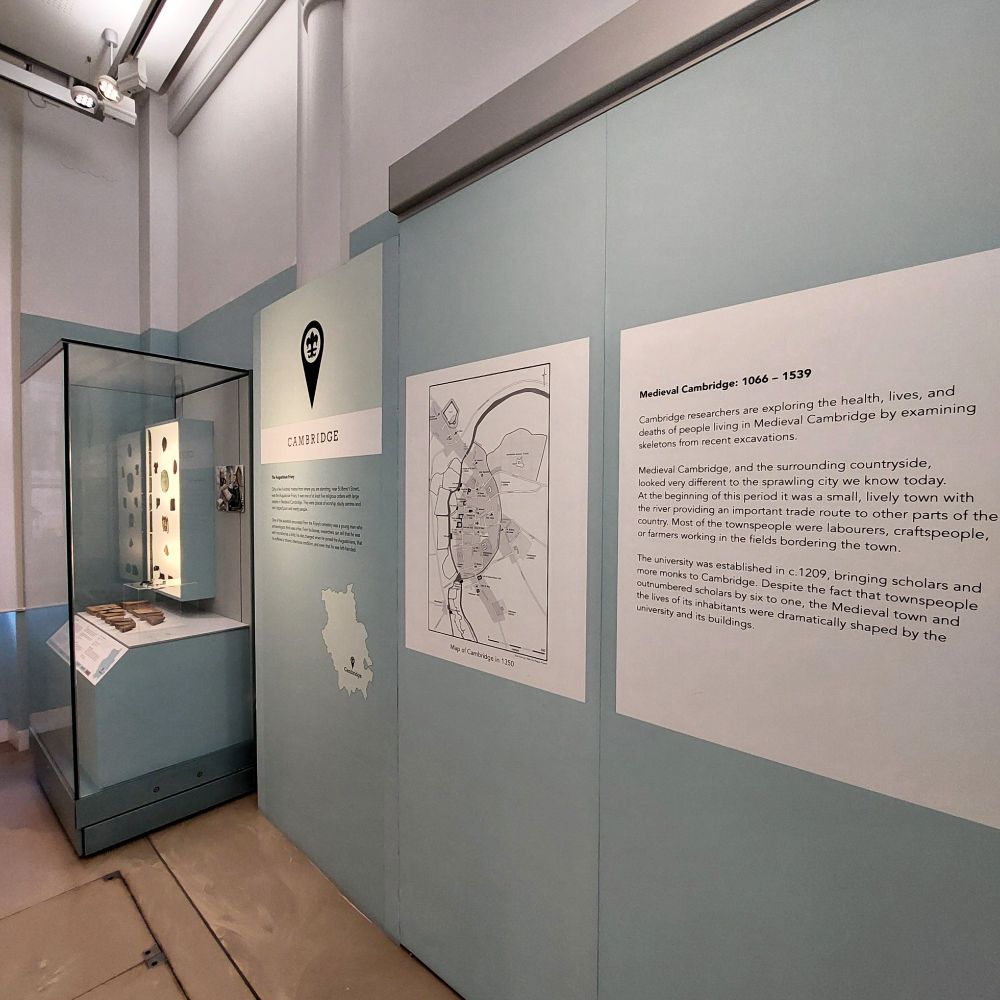
A photograph of an exhibit displaying medieval artefacts from an Augustinian Friary found in the centre of Cambridge. The display includes a map and further information about medieval Cambridge 1066-1539.
Very happy that I managed to visit the 'Beneath our Feet' exhibition at the MAA in Cambridge just before it finished. It was exciting (and humbling) to see so many things on display that myself and lots of my amazing colleagues have worked on! @samleggs22.bsky.social @ecbrownlee.bsky.social 🏺
25.09.2024 14:37 — 👍 10 🔁 2 💬 0 📌 0
The colosseum flowing in the setting sun
In Rome for #EAA2024. On Friday will be chairing and speaking in session 182 on non-burial treatment of the dead. Including a sneak preview of my and Ali Klevnäs’s forthcoming
@antiquityj.bsky.social
paper!

If you haven't had enough of me talking about bed burials, here’s a short piece on the Trumpington one, currently on display in the Museum of Arch and Anth in Cambridge
18.02.2024 13:59 — 👍 3 🔁 0 💬 0 📌 0
Exciting find of a Roman bed burial - extending the funerary use of beds in England back in time by at least three centuries. Different to the 7th cent ones (with a male, for a start). But wooden construction raises questions about what we're missing. Will be interesting to get a more precise date!
05.02.2024 12:20 — 👍 4 🔁 0 💬 0 📌 0More bed burials, this time a deep-dive on the Trumpington girl! Featuring Sam Leggett and @alicekensa.bsky.social
on their amazing isotope work, some broader context from me, and what it was like bringing everything together for the
MAA Cambridge 'Beneath our feet' exhibition.

Poster text: Invisible or hard to see Non-burial treatment of the dead in the archaeological record Session 182 30th EAA Annual Meeting, 28 - 31 August 2024, Rome Session Organizers Alison Klevnäs (Uppsala University, alison.klevnas@arkeologi.uu.se) Emma Brownlee (University of Cambridge), Sophie Bergerbrant (Uppsala University) For full abstract see: https://www.e-a-a.org/EAA2024/Programme.aspx?WebsiteKey=20b5538d-68f8-4056-9596-1ae1ce0ead47&hkey=fe6595a9-39e9-47f1-8159-520091f89dfa&Program=3#Program
Call for papers for #eaa2024 in Rome!
We're interested in ways of interacting with dead bodies beyond simple burying or burning, and how we might identify such practices. Any period, any place.
Submit abstracts here by 8th Feb: submissions.e-a-a.org/eaa2024/
All the code and data are included in the supplementary material, so it’s easy to update these models to take into account new dates as they come out #openscience
12.12.2023 17:33 — 👍 0 🔁 0 💬 0 📌 0There’s also a more nuanced picture in the paper of regional variations and gender differences, as well as cemetery sizes. Some of my results directly contradicts stuff I’ve previously published! Which is a bit frustrating, but all part of the research process.
12.12.2023 17:33 — 👍 0 🔁 0 💬 1 📌 0It also shows that there is some limited furnishing continuing into the 8th cent, possibly over-represented in the c14 dates, but very much real. Suggests other models of grave good change relied too much on artefact typologies, whereas c14 dates cover the full range of furnishing
12.12.2023 17:33 — 👍 0 🔁 0 💬 1 📌 0
A graph showing the frequency of furnished burial (based on radiocarbon dates) from 300-900AD. Levels are very low from 300-400, increase from 400 onwards, reaching a peak around 600AD. After this it rapidly drops off across the seventh century, persists at a low level in the eighth century, and returns to very low levels in the ninth century.
Using a method of kernel density estimation (and correcting for any marine reservoir effects), this shows a peak in grave good use around 600AD. A point in time when other models have suggested there wasn’t much furnishing going on, outside very rich graves like Sutton Hoo
12.12.2023 17:32 — 👍 0 🔁 0 💬 1 📌 0The principle of this method is that if you have enough c14 dates, you can use them as a proxy for past activity levels. Most commonly used for demographic studies, but here I’m interested in funerary behaviour. I’ve got nearly 1100 dates from burials from across the 1st millenium AD.
12.12.2023 17:31 — 👍 0 🔁 0 💬 1 📌 0New paper alert!
"A radiocarbon-based model of changing burial rites in early medieval England" Published today in Radiocarbon
Using big data to answer the question of what happens to grave goods in the 7th century, and more.
Summary🧵
doi.org/10.1017/RDC....

From a colleague in Ukraine on the ongoing impact of the war on archaeological sites, and the destruction we still don't know about
01.12.2023 10:50 — 👍 0 🔁 0 💬 0 📌 0
Some brief thoughts on using big data to understand 7th cent changes in burial practice - based on a talk last year for the Sutton Hoo Society. I'll also be talking on a similar topic tomorrow at a Newcastle Archaeology seminar, and the c14 project should be fully published in Radiocarbon soon!
15.11.2023 15:18 — 👍 18 🔁 4 💬 1 📌 1